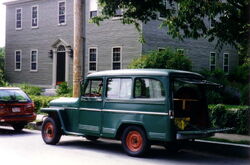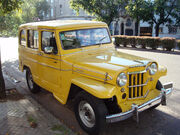m (new) |
m (cat) Tag: sourceedit |
||
| Line 61: | Line 61: | ||
[[Category:Jeep vehicles]] |
[[Category:Jeep vehicles]] |
||
[[Category:Motor vehicles manufactured in the United States]] |
[[Category:Motor vehicles manufactured in the United States]] |
||
| + | [[Category:Trucks built in the United States]] |
||
| + | [[Category:SUVs]] |
||
Latest revision as of 23:14, 9 May 2015
 | |
| Manufacturer |
Willys Kaiser-Jeep |
|---|---|
| Production | 1946–1965 |
| Successor | Jeep Wagoneer |
| Class | Full-size SUV |
| Body style(s) |
2-door wagon 2-door panel 4-door wagon |
| Wheelbase | 104.5 in (2,654 mm) |
| Length | 176.25 in (4,477 mm) |
| Width | 71.75 in (1,822 mm) |
| Height | 74 in (1,880 mm) |
| Curb weight |
3,206 lb (1,454 kg) 4,500 lb (2,041 kg) GWV |
| Related |
Willys Jeep Truck Willys Jeepster |
The Willys Jeep Station Wagon is the first mass-market all-steel station wagon designed and built as a passenger vehicle[1] and is arguably the world's first popular sport utility vehicle or SUV (the heavy-duty, truck-based Chevrolet Suburban with steel body was introduced in 1939 for professional use mainly as train depot hacks[2] and funeral homes[3]). The Willys Jeep was designed in 1946 by industrial designer Brooks Stevens and the station wagon stayed in production until 1965.
The steel body was efficient to mass-produce, as easy to maintain and safer than the real wood-bodied station wagon versions at the time. This was one of Willys' most successful post-World War II models. Its production coincided with individual consumers moving to the new suburbs during the post-war period.
This model was also assembled in several international markets under various forms of joint ventures, licenses, or Complete knock down kits.

Willys Jeep "Estanciera" made by Industrias Kaiser Argentina (IKA) in Argentina
Production
The Willys Jeep Station Wagon was introduced in 1946 as just the 463 model, powered by the L-134 Go-Devil flathead four cylinder. The 663 model, powered by the L-148 Lightning straight six, was brought in for 1948. Four-wheel drive became an option in 1949.
1950 saw a number of changes. The flat grille was replaced by a pointed v-shape design with five horizontal bars across the vertical ones. New engines were available, too. The 473 model got the new F-134 Hurricane, and the 673 model got a new 161 cu in (2.6 L) version of the Lightning six. Another big change this year was the addition of a sedan delivery model to the lineup.
In 1952, the flathead Lightning was dropped in favor of the F-161 Hurricane, installed in the 685 model.
The 1954 model year was the first under Kaiser's ownership. The 6-226 Super Hurricane, a flathead inline six, was introduced. This was a version of the Kaiser Supersonic/Continental Red Seal engine.
A number of new models were added in 1955. The 6-226 model lineup gained stripped chassis, flat face cowl, cowl/windshield, and ambulance models. The 475 line received only the cowl/windshield.
In 1958 a new Maverick model was introduced, a comparatively more luxurious version of the two-wheel drive wagon. It could be had with only with the four-cylinder engine. The main upgrades were in the introduction of 2 tone paint with matching interior in 2 tones and the standard AM radio. The easiest way to identify a Maverick is by the extra (stainless steel)trim ring under the windows. The Maverick tag came from the TV show of the same name, of which Willys was a sponsor.
The 6-230 Tornado OHC engine was introduced in midyear 1962, replacing the flathead.
Production ended in 1965, as the Willys model had been phased out by the Jeep Wagoneer. Over 300,000 wagons and its variants were built in the U.S.
Engines
- 1946-50 L4-134 Go-Devil
- 1948-50 L6-148 Lightning
- 1950-65 F4-134 Hurricane
- 1950-51 L6-161 Lightning
- 1952-54 F6-161 Hurricane
- 1954-62 L6-226 Super Hurricane
- 1962-65 6-230 Tornado
References
| This page uses some content from Wikipedia. The original article was at Willys Jeep Wagon. The list of authors can be seen in the page history. As with Tractor & Construction Plant Wiki, the text of Wikipedia is available under the Creative Commons by Attribution License and/or GNU Free Documentation License. Please check page history for when the original article was copied to Wikia |
- ↑ Olsen, Byron (2000). Station Wagons. MBI Publishing, 27. ISBN 9780760306321. Retrieved on 4 August 2010.
- ↑ Vincent, Van (12 February 2010). "Chevrolet Suburban at 75 years old-Looking back". CarguideBlog. Retrieved on 4 August 2010.
- ↑ Bradsher, Keith (2002). High and Mighty: SUVs: The World's Most Dangerous Vehicles and How They Got that Way. PublicAffairs, 5. ISBN 9781586481230.
- Foster, Patrick R. (2003). Standard Catalog of Jeep 1940-2003. Krause Publications. ISBN 9780873495226.
- Redmond, Derek (24 June 2002). "Willys Jeep Station Wagons". The CJ-3B Page. Retrieved on 2007-03-22.
| Jeep road vehicle timeline, 1945–1970s — next » | |||||||||||||||||||||||||||||||||||
|---|---|---|---|---|---|---|---|---|---|---|---|---|---|---|---|---|---|---|---|---|---|---|---|---|---|---|---|---|---|---|---|---|---|---|---|
| Type | 1940s | 1950s | 1960s | 1970s | |||||||||||||||||||||||||||||||
| 5 | 6 | 7 | 8 | 9 | 0 | 1 | 2 | 3 | 4 | 5 | 6 | 7 | 8 | 9 | 0 | 1 | 2 | 3 | 4 | 5 | 6 | 7 | 8 | 9 | 0 | 1 | 2 | 3 | 4 | 5 | 6 | 7 | 8 | 9 | |
| Traditional | CJ-2A | CJ-3A | CJ-5 | ||||||||||||||||||||||||||||||||
| CJ-3B | CJ-7 | ||||||||||||||||||||||||||||||||||
| CJ-6 | |||||||||||||||||||||||||||||||||||
| Dispatcher | DJ-3A | DJ-5/6 | |||||||||||||||||||||||||||||||||
| Compact SUV | VJ | C101 | C104 | ||||||||||||||||||||||||||||||||
| SUV | Willys Jeep Wagon | Jeep Cherokee (SJ) | |||||||||||||||||||||||||||||||||
| Wagoneer SJ | |||||||||||||||||||||||||||||||||||
| Compact pickup | Commando | ||||||||||||||||||||||||||||||||||
| Full-size pickup | Willys Jeep Truck | ||||||||||||||||||||||||||||||||||
| Gladiator | Honcho/J10-20 Series | ||||||||||||||||||||||||||||||||||
| Truck | Forward Control | ||||||||||||||||||||||||||||||||||
| Van | FJ-3/3A | ||||||||||||||||||||||||||||||||||